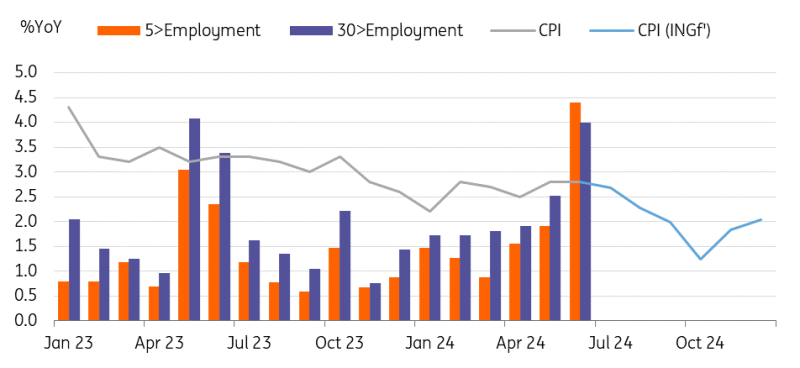Asia Morning Bites For Tuesday, Aug 6
Image Source: Unsplash
Global Macro and Markets
- Global Markets: So, at least some of the knives have stopped falling. And some reassuring comments by Fed officials (Daly most notably) have helped to allay some of the markets’ concerns. 2Y US Treasury yields have actually risen slightly (+4 basis points) overnight, though the 10Y is roughly unchanged at 3.788% after reaching as low as 3.66% at one point. US stocks still opened sharply lower, but there was a slight recovery shortly after the open and most of the rest of the session was flattish. The S&P 500 still closed 3% lower, and the Nasdaq 3.43% lower than the previous day’s close, but US equity futures are looking at a much brighter open today, so perhaps the market is concluding that the sky is not falling in after all. That would be welcome news for Asian stocks, which took a battering yesterday. The Nikkei 225 fell more than 12%. And there were double-digit falls for the KOSDAQ and Taiwan stocks were down more than 8%. We could see some stabilisation today. EURUSD crept higher yesterday and is now sitting at about 1.0950. The AUD, which dropped as low as 0.6350 at one point yesterday, is back in the low 65-cent range. USDJPY has also moved higher and is back at 145.18. Cable is a slight outlier, and is trending slightly weaker over the last 24 hours. Non-G-10 Asian FX made strong gains yesterday, led by the MYR which has dropped to 4.42, a level it last traded in April 2023. USDCNY is now just below 7.14.
- G-7 Macro: With all the talk of recession and emergency Fed cuts, it is good to see that some of the US data was reasonably positive yesterday. Although somewhat redundant, coming in after payrolls, the service sector ISM for July registered a better-than-expected increase to 51.4, taking it out of contraction territory. There was better news from new orders as well, and the employment index also rose above the 50 threshold indicating growth. Less welcome will be the rise in the prices paid component, which rose to 57.0 from 56.3 and suggests that there are still inflation issues in the service sector. The macro calendar for today is relatively quiet. Eurozone retail sales for June are probably too dated to have much of a market impact. The US publishes June trade data too.
- Australia: Given the carnage in global markets, we are scrapping our forecast for a rate hike from the RBA. It was, in any case, hanging in the balance after the improvement in core inflation figures in the 2Q24 release, and the current market volatility makes this an almost certain “no-change” meeting today. The RBA still has some inflation issues. But for now, we think the most probable outlook is for stable rates over the rest of the year.
- Philippines: We expect July inflation will come in at 4.0%YoY, up from 3.7% in June, but a little lower than the 4.1% consensus view. So far, we see little evidence of price declines in rice, which has been generating much of the inflation lately, but it is at least not currently rising and even if that is all that happens, inflation should quickly start to subside in the months ahead. A big upside miss to today’s figures could push back BSP aspirations to cut rates in August. But with the PHP gaining some support as the USD weakens in the current market volatility, an August cut remains a possibility.
- Taiwan: Taiwan publishes its CPI inflation data in the afternoon. We are looking for inflation to edge up a little from 2.4% to 2.5% YoY in July, as housing prices continued to move higher and existing pressures from food and healthcare prices remained. Barring a much more significant than expected uptick in inflation, we doubt there will be much of an impact on Taiwan’s monetary policy direction.
- Japan: Labour cash earnings data beat the market consensus, justifying the BoJ’s rate hike last month. Cash earnings rose 4.5% YoY in June (vs 2.0% May, 2.4% market consensus) and a more stable measure, the same-sample cash earnings rose even higher (5.4% vs 2.3% in May, 3.5% market consensus). More importantly, real wages rose 1.1% YoY (vs -1.3% in May, -0.9% market consensus), the first rise in 27 months. We are clearly seeing signs of solid wage growth as the spring wage negotiation results are finally having a more meaningful impact. However, solid wage growth hasn’t yet fully boosted household spending, which dropped -1.4% YoY in June (vs -1.8% in May, -0.8% market consensus). The pace of contraction moderated though.
- We continue to believe that solid wage growth is likely to boost consumption, broadly in line with the BoJ’s projection. For now, we have pencilled in a rate hike in October and today’s data supports our view. However, the volatile financial market conditions, especially rapid JPY appreciation, are lowering the probability of an October rate hike. The short-term market volatility won’t change the course of the BoJ’s policy normalization, but the pace may be slower than we expect if it continues.
Real cash earnings rose for the first time in 27 months

Source: CEIC
What to look out for: Japan labor cash earnings, Australia RBA cash rate target, Taiwan CPI & GDP
August 6th
Japan: June labour cash earnings
Philippines: July CPI, Imports, Exports, Trade balance
Australia: RBA cash rate target
Taiwan: July Core CPI, CPI, GDP
US: Trade Balance
August 7th
S Korea: BoP current account balance
Philippines: June unemployment rate
India: July foreign reserves
Japan: June leading index CI
China: July exports, imports, Trade balance, foreign reserves
August 8th
Japan: BoP current account balance, Trade balance BoP basis
Philippines: 2Q GDP
India: RBI repurchase rate, RBI cash reserve ratio
Taiwan; July imports, exports, trade balance
August 9th
Japan: July money stock M2 & M3
China: July CPI, PPI, Money supply (Due 15th August)
More By This Author:
Fed To Step On The Gas, But Market Pricing Looks AggressiveMonitoring Hungary: Hopes For Growth Face A Reality Check
Turkey Sees Big Drop In Annual Inflation On Base Effects But July Prices Remain High
Disclaimer: This publication has been prepared by ING solely for information purposes irrespective of a particular user's means, financial situation or investment objectives. The information ...
more



